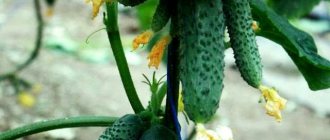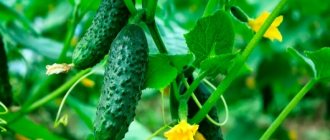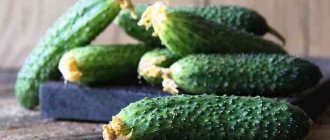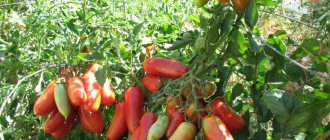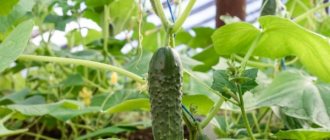Bettina F1 cucumbers are high-quality Dutch hybrids. The seeds are not the cheapest, but the quality is worth it: the hybrid can be grown in any conditions, get a stable early harvest and enjoy fresh vegetables or store them for the winter.
| Landing location | Ripening time | Mode of application | Fruit length | Group | Fruit smoothness | Pollination method |
| Universal | Early ripening (35-45 days) | Universal | Medium - from 10 to 15 cm | Hybrid | Highly lumpy | Parthenocarpic |
History of variety development
The Bettina F1 cucumber was bred by Dutch breeders at the beginning of this century (in 2007) and almost immediately it attracted the attention of vegetable growers from around the world, including Russia. As a result, this cucumber hybrid underwent variety testing in Russia, and in 2010 it was included in the Russian State Register. At the same time, Bettina F1 cucumber was recommended for cultivation in most Russian regions.
Important to know:
What are F1 and GMO hybrid seeds
Requirements for growing conditions
Bettina cannot be called a capricious hybrid. The advantages of the plant are early ripening, cold resistance, no need for pollination, resistance to crop diseases. But you need to know some rules for growing, because only with proper care will the variety produce the most abundant and tasty harvest.
This cucumber variety requires the following conditions:
- In southern latitudes, the seeds are sown directly into the ground; in the northern regions, Bettina is grown by seedlings.
- No more than 2-3 seedlings are placed per 1 m2, otherwise the plants will be cramped.
- The hybrid is grown on trellises.
- In cold climates, it is better to grow in a polycarbonate greenhouse - the yield will be much higher than on the plot.
- Like other cucumbers, Bettina is moisture-loving - it requires abundant watering. Moisture is introduced into the grooves around the bush; drops should not fall on the leaves and stems.
- The bush needs nitrogen-potassium fertilizers. During fruiting, plants are additionally fed with calcium and magnesium. Bettina accepts both mineral complexes and organic matter, such as mullein solution, well.
- The formation of the bush is minimal - stepsons are removed only in the first 4-5 axils.
Hybrid seeds are not suitable for collection and planting. You will have to buy new planting material every time.
Description
This hybrid is early ripening - almost 1.5 months pass from the moment the seed material germinates until the first greens are harvested. This cucumber is classified as an indeterminate type; its cucumber vines are not limited in growth. Side shoots are formed in limited quantities.
The Bettina cucumber is a parthenocarpic type, so only female flowers appear on the vines. And most fruits are set only on the central stem.
The bushes of this hybrid should not be formed, since its vegetative stepsons stop growing at a height of 1.5 m, and subsequently fruits are set on developing stepsons. Therefore, there is no need to delete them. The cucumber vines are well leafy, the foliage is of medium size, slightly wrinkled, dark green in color.
Related article:
Cucumber Ajax F1 - description and characteristics of an early variety
Due to the fact that this variety is early ripening, it can be grown twice per season, and grown in heated greenhouses all year round.
This variety is characterized by a bunched type of ovary formation. in this case, from 1 to 4 cucumbers can form in each leaf axil.
Ripe cucumbers of this variety are cylindrical in shape and small in size. Their length can be up to 10 cm, and their weight is about 70-80 g.
The best varieties of cucumbers for the greenhouse
The surface of the fruit is leveled and homogeneous. The skin is of medium thickness, dark emerald in color, with small light stripes. All over the surface of the green grass there are small tubercles with brown thorns. Pubescence is of medium density.
The pulp is tender and quite juicy; there is no bitterness in it at the genetic level. There are no voids in the gherkins, and they do not appear even during heat treatment.
You can harvest at the gherkins and pickles stage. Moreover, the more often ripe greens are collected, the more new ovaries are formed. The harvested crop can be transported to any distance, without deteriorating the appearance and taste of the gherkins.
Main characteristics of the variety
This hybrid is unpretentious to growing conditions and does not require special care, so even novice summer residents can grow it.
Cucumber Bettina F1
Productivity
The variety is distinguished by excellent productivity - at least 5 kg of ripe gherkins can be harvested from each square of area. In addition, this hybrid is distinguished by the friendly ripening of fruits, most of which ripen within 25-30 days from the beginning of fruiting.
Related article:
7 fatal mistakes when growing cucumbers that every gardener should avoid
Area of application of fruits
Ripe gherkins and pickles are intended for fresh consumption, pickling and canning. Moreover, during heat treatment, voids do not appear inside the cucumbers, and the taste remains the same.
Cross-section of Bettina F1 cucumber
Diseases and pests
Like all cucumber hybrids of Dutch selection, this cucumber has high resistance to most diseases characteristic of other varieties of this vegetable crop, including powdery mildew, cladosporiosis, common mosaic virus, and downy mildew.
Important! Why do cucumber leaves turn yellow: 6 main reasons
Diseases and pests
"Bettina f1" is resistant to common diseases, but preventive measures will help further reduce the likelihood of diseases occurring. Early ripening varieties are not treated with chemicals, as toxic substances can be deposited in early greens. Therefore, folk remedies are used to treat early ripening varieties:
- to prevent powdery mildew, plants are sprayed with 20 g of laundry soap without fragrances and dyes, 9 liters of warm water, 1 liter of skim milk, 30 drops of iodine;
- for gray rot, water the bushes at the root with water and baking soda (75 g of soda per bucket of water);
- for bacteriosis, use trichopolum (2 tablets per 1 liter of water).
Many pests will be repelled by garlic and onions planted between rows of cucumbers. To protect the plantings from spider mites and slugs, the bed must be dug up in the fall so that the soil freezes.
The main advantages of the variety
The main advantages of the cucumber hybrid Bettina F1 include:
- high productivity;
- unpretentiousness to growing conditions;
- It does not require special care;
- resistant to stressful weather conditions, sudden drops in temperature, lack of lighting;
- ripe fruits can be picked not only at the gherkin stage, but also at the pickle stage;
- the harvested crop can easily withstand transportation over any distance and has a long shelf life;
- resistant to most diseases that affect other varieties of cucumbers.
Advantages and disadvantages
Positive characteristics of the hybrid:
- Plants normally tolerate unexpected drops in temperature. Other varieties stop growth and development under such conditions.
- Lack of light does not affect productivity.
- The cucumber practically does not produce stepsons, which does not require much time for care.
- Fruits are formed early. It is possible to grow a cucumber twice in one season.
- Yield indicators cannot be called high, but for the early period they are quite acceptable. From 1 plant you get up to 5 kg.
- In terms of use in the kitchen, cucumber is considered universal. The fruits are prepared as gherkins, eaten in salads and on their own.
As a minus, they note the high cost of seeds.
Features of planting and care
Any cucumber hybrids are unpretentious to growing conditions; they also do not need special care - they practically do not get sick and bear fruit even in unfavorable weather conditions.
Typically, cucumbers of this variety are grown in open ground, but they are successfully grown in regions with unfavorable climatic conditions in film greenhouses and greenhouses.
Related article:
Pinching cucumbers: why and how to do it
To get really early production, you should grow the Bettina F1 hybrid in seedlings. To protect it from returning spring frosts, it is planted in garden beds no earlier than the first ten days of May. Therefore, seedlings are planted in the first half of April.
And in regions with an unpredictable climate (Siberia, the Urals), cucumbers begin to be grown in open ground no earlier than the end of May - beginning of June, so seedlings are planted in the last ten days of April.
In order for cucumbers in garden beds to grow and bear fruit well, it is necessary to select the right area for growing them and prepare it correctly.
Cucumbers need a well-lit area with light, fertile soil. Therefore, during the autumn digging, humus or rotted compost is added to the soil, and in the spring mineral fertilizers are added to the holes. In open ground, cucumber seedlings are planted as follows: no more than 4 cucumber bushes should be placed on each square of area. And it doesn’t matter if the cucumber vines grow greatly during growth and begin to block each other’s light - this cucumber hybrid grows well and bears fruit in light partial shade.
Therefore, the bushes of the Bettina F1 hybrid do not need to be formed and the lateral stepsons on which fruiting will occur need to be removed.
Of the top dressings, this vegetable crop is most susceptible to organic fertilizers. Therefore, most often, cow manure diluted with water (in a ratio of 1:10), horse manure (in a ratio of 1:10) or chicken manure, which must be diluted with water in a ratio of 1:20, is added to cucumber beds. You can also add an infusion of wood ash, which contains a large amount of macro and microelements, to the beds where cucumbers of this variety grow.
Related article:
Murashka F1 cucumber - description and characteristics of an early variety
You should also apply complex mineral fertilizer with a high phosphorus content to cucumbers of this variety at least once a season. In the process of caring for this cucumber crop, the following agrotechnical measures should be carried out:
- in the evening hours, watering with water heated in the sun is carried out strictly at the root, so that drops of water do not fall on the foliage;
- Once every 6-8 days, cucumber vines are fed with the fertilizers described above;
- After each watering or rain, you need to loosen the root zone of the cucumber vines in order to break up the dry crust that forms on the surface of the earth. This operation must be carried out carefully so as not to damage the root system of plants located close to the soil surface. At the same time, you need to remove all weeds in which harmful insects may be hiding.
Reviews from summer residents
Natalya from Kursk. I have been growing cucumbers on my plot for 3 years in a row. For this I use a film greenhouse. There is not much work to do with it: let the whip fall on the support and calmly wait for the harvest. I use organic matter as a fertilizer (infusion of cow dung and grass). The fruits ripen very early - after 35-40 days. I harvest before the cold weather. For the most part, I put gherkins in jars for the winter. We eat the rest fresh.
Valentina from the Moscow region. I grow early vegetables under film. I saw the presented cucumber last year in a photo of one of the agricultural sites. I studied the description and then decided to order the seeds. The seedlings were powerful, larger than others. The cucumber grew quickly and soon produced a high-quality harvest. The taste of gherkins is delicate and crispy.
Bettina is a hybrid cucumber that will delight you with an early harvest. Compliance with simple rules of agricultural technology guarantees the production of tasty greens under any conditions.
